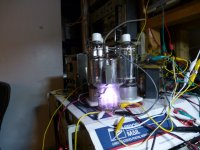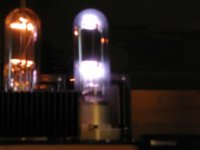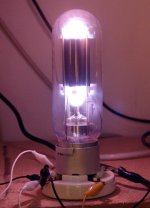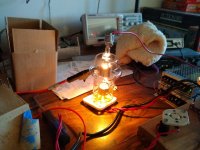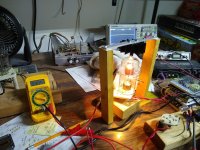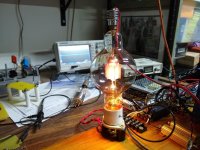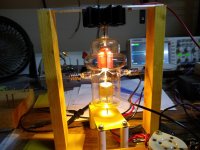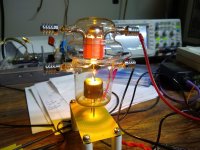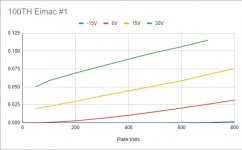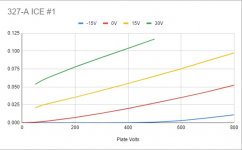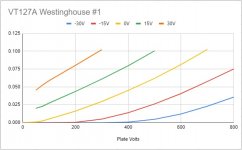There's too much gas inside, much more than any getter could absorb
I couldn't fix this one either despite all the usual tricks.
Attachments
I'd also toss away the tube from #32. There's too much gas inside, much more than any getter could absorb.
Even better, I've sent it back to the vendor to exchange it for another! Hopefully no gas in this one.
get both tubes good and hot with at least 1000 volts on the plate before hooking up an output transformer.
Or using it in a circuit that contains a mosfet.
I brought home a pair of 211's that I bought at a hamfest cheap. The seller said "they worked the last time I used them." I was dumm enough to plug both in my amp, set the bias to its most negative voltage and flip the power switch......one tube lit up purple and the mosfet on the grid was dead.
Later I tried to "cook" the tube with a power supply, but like the tube in the previous picture, it only got worse with time.
Attachments
I was testing one of these guys (327-A, but not the one in this picture) and it isn't working. I'm getting the following symptoms:
1. Absolutely no plate current at any plate voltage.
2. No ionized gas cloud.
3. Plate shows some color.
4. No smoke from filament on power-up.
I'm thinking this is an obviously dead tube, but want to check my reasoning here.
It seems that the plate couldn't give color without plate current without there being gas inside to transfer extra filament heat to the plate. It is a pretty high power filament radiating heat (110W), but other functioning samples of this type show no plate color with no plate voltage/current. I'm thinking it is full of air but I didn't see any smoke at power-on like I saw with a couple of 826s. I did see that the inside of the plate structure was a darker color after powering down, as if there was some oxidation to the metal while I ran it. It was silver, now it is bluish.
I'm thinking the cathode surface is just ruined so it can't emit enough electrons to make an ionized gas cloud.
Does that seem reasonable?
1. Absolutely no plate current at any plate voltage.
2. No ionized gas cloud.
3. Plate shows some color.
4. No smoke from filament on power-up.
I'm thinking this is an obviously dead tube, but want to check my reasoning here.
It seems that the plate couldn't give color without plate current without there being gas inside to transfer extra filament heat to the plate. It is a pretty high power filament radiating heat (110W), but other functioning samples of this type show no plate color with no plate voltage/current. I'm thinking it is full of air but I didn't see any smoke at power-on like I saw with a couple of 826s. I did see that the inside of the plate structure was a darker color after powering down, as if there was some oxidation to the metal while I ran it. It was silver, now it is bluish.
I'm thinking the cathode surface is just ruined so it can't emit enough electrons to make an ionized gas cloud.
Does that seem reasonable?
Attachments
Air doesn't ionize well if at all at 1 ATM of pressure, it usually breaks down and arcs. The glowing 211 in my picture still has a partial vacuum. I have a leaky 6LW6 that used to make a nice bright deep blue glow. After a few years of hanging out under my bench I fired it up, but get only a little glow but lots of sparks.
You should get a small negative voltage on the grid with the filament powered up. Try a good tube, then try the questionable one.
If you have a source of high voltage at low current that's capable of making a 1/2 inch spark (car ignition coil and 9 volt battery) try it between grid and plate. Unless your voltage is real high there should be no spark in a vacuum. If it sparks inside like it does out on the bench, the tube is one with the atmosphere.
You should get a small negative voltage on the grid with the filament powered up. Try a good tube, then try the questionable one.
If you have a source of high voltage at low current that's capable of making a 1/2 inch spark (car ignition coil and 9 volt battery) try it between grid and plate. Unless your voltage is real high there should be no spark in a vacuum. If it sparks inside like it does out on the bench, the tube is one with the atmosphere.
George,
"It worked the last time I used it." Means that I stopped being able to use it! A code phrase for it does not work.
I have a 3CX15000A7 that requires 7 volts at 50 amps for the filament. Really not easy to test. It is labelled as rebuilt and was kept as a spare at an FM station transmitter site.
Have a similar one for the driver 3CX3000A7!
Also got in a transmitter with an exciter, four 600 watt linear amplifiers and a passive combiner. All solid state. Have to borrow a dummy load to check it out. 2,000 Watt complete FM transmitter.
Picked up quite a few other bits and bobs.
Unfortunately these are leftovers from a radio station whose chief engineer was not as skilled as he thought he was.
There may also be coming in a water damaged 15,000 watt complete solid state transmitter.
"It worked the last time I used it." Means that I stopped being able to use it! A code phrase for it does not work.
I have a 3CX15000A7 that requires 7 volts at 50 amps for the filament. Really not easy to test. It is labelled as rebuilt and was kept as a spare at an FM station transmitter site.
Have a similar one for the driver 3CX3000A7!
Also got in a transmitter with an exciter, four 600 watt linear amplifiers and a passive combiner. All solid state. Have to borrow a dummy load to check it out. 2,000 Watt complete FM transmitter.
Picked up quite a few other bits and bobs.
Unfortunately these are leftovers from a radio station whose chief engineer was not as skilled as he thought he was.
There may also be coming in a water damaged 15,000 watt complete solid state transmitter.
Last edited:
From the picture the filament has a perfect color, so there is no air in the tube. From your description that tube is as dead as Kelsey's nuts or could it be that your HV negative lead is not connected?
Sorry, I probably wasn't very clear. The picture is of a tube that worked fine.
I didn't get a picture of the bad tube as I attempted to operate it, but it looked very similar to this one, except the plate was showing about as much color as if it was dissipating 50W-70W or so.
I can check the return sense lead, but I didn't change the setup between the two tubes so I don't think it was the problem.
Anyway, I'll try to fire it up one more time and at least get a good photo and check my return/sense setup.
My main point of confusion was the plate showing color with no plate current or voltage and a grounded grid (and no cathode current). The extra heat has to be getting into the plate somehow to get it to show color. The only thing I could think of was that there was significant gas in the tube that was acting to transfer more heat from filament to plate.
The other three samples of this tube that I own show no plate color with grounded grid and no plate voltage.
This particular tube was given to me years ago for free, just as an interesting-looking tube. It also has the tip of one of the filament leads broken off, so they are unequal length. Someone handled it roughly at some point.
The other three samples of this tube that I own show no plate color with grounded grid and no plate voltage.
This particular tube was given to me years ago for free, just as an interesting-looking tube. It also has the tip of one of the filament leads broken off, so they are unequal length. Someone handled it roughly at some point.
Last edited:
George,
"It worked the last time I used it." Means that I stopped being able to use it! A code phrase for it does not work.
In my case it probably did work the last time I used it, but that might have been nearly 50 years ago.
I have found that there are two types of water damaged electronics, and the probability of successful repair depends on which type. This is determined by one thing, whether or not power was applied when the water came.
Another thing to check with the dead tube is the presence of corrosion on the plate pin. I have seen some nasty non conductive stuff grow on tubes left in the Florida humidity for say 20 years.
I fired up my test setup again and discovered that my homemade grid caps were made of aluminum that was too soft and the threads stripped and it wasn't engaging properly. I ran one of the good tubes and got 12.5mA with a few hundred volts on the plate and grounded grid.
I stuck the "bad" tube in the setup and I had to do something funky with the filament pins because they are unequal length, but ignore that. Plate was showing more color than the "good" tube, but I did get a small current flow this time (0.5mA @ 400V plate with grounded grid). There's electron flow now, no visible gas cloud or arcing, although gas cloud would be hard to see in this thing since the filament is so bright. Still, it isn't acting like it is gassy.
Now these are different brands of tubes (Westinghouse vs Eimac), so the plates might just differ in what it takes to make them show color. It is a 110W filament, so there is already a lot of heat hitting the plate with no plate current.
Basically, I'm going to ignore all of my results up to this point and make my setup more solid. I ordered correct Eimac grid caps for these (I can't find the correct HR4 plate cap, so my homemade plate cap will stay). I just want to have a good solid setup before I cook these for a while and see where they stabilize.
I stuck the "bad" tube in the setup and I had to do something funky with the filament pins because they are unequal length, but ignore that. Plate was showing more color than the "good" tube, but I did get a small current flow this time (0.5mA @ 400V plate with grounded grid). There's electron flow now, no visible gas cloud or arcing, although gas cloud would be hard to see in this thing since the filament is so bright. Still, it isn't acting like it is gassy.
Now these are different brands of tubes (Westinghouse vs Eimac), so the plates might just differ in what it takes to make them show color. It is a 110W filament, so there is already a lot of heat hitting the plate with no plate current.
Basically, I'm going to ignore all of my results up to this point and make my setup more solid. I ordered correct Eimac grid caps for these (I can't find the correct HR4 plate cap, so my homemade plate cap will stay). I just want to have a good solid setup before I cook these for a while and see where they stabilize.
Attachments
George,
It was an active transmitter that got wet. The power supplies did not shut down, only the RF problem detector dropped the signal.
I sent a repair price to the folks. I suspect they will just replace it with something newer. The savings in electricity should actually pay for a new one.
It was an active transmitter that got wet. The power supplies did not shut down, only the RF problem detector dropped the signal.
I sent a repair price to the folks. I suspect they will just replace it with something newer. The savings in electricity should actually pay for a new one.
I've been acquiring various tubes to experiment with and I drew a few curve sets with my tester setup.
Attachments
HY-75 looks like a fun little tube. It's kind of funny to have a filament rated for more power than the plate.
The 327A above has a 100W plate rating and a 112W filament. It was built for pulse duty in radar transmitters so I guess lots of peak emission was probably important, but man it's bright. The photos don't really show it well.
I'm going for unusual-looking tubes on this project, so I'm glad I got some deals on some of these old radar tubes. I had to make my own socket. Thanks for the earlier tip to look at Mill Max sockets. That did the trick.
The 327A above has a 100W plate rating and a 112W filament. It was built for pulse duty in radar transmitters so I guess lots of peak emission was probably important, but man it's bright. The photos don't really show it well.
I'm going for unusual-looking tubes on this project, so I'm glad I got some deals on some of these old radar tubes. I had to make my own socket. Thanks for the earlier tip to look at Mill Max sockets. That did the trick.
- Home
- Amplifiers
- Tubes / Valves
- Transmitter Tube Testing
